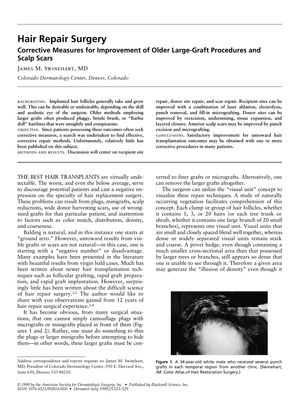Corrective Hair Repair Surgery Techniques
July 1999
in “
Dermatologic Surgery
”

TLDR Corrective hair repair surgery can significantly improve appearance and quality of life for patients with unsatisfactory results from old hair transplants.
The document from 1999 by James M. Swinehart, MD, with 12 years of experience, discusses corrective hair repair surgery techniques for patients with unsatisfactory outcomes from older hair transplantation methods. It highlights the inadequacy of simply camouflaging old plugs with micrografts and suggests that larger grafts should be refined or removed using methods like laser ablation, electrolysis, punch removal, and micrografting. Donor site enhancement techniques such as reexcision and tissue expansion are also described. The author introduces the "visual unit" concept for a more natural appearance and favors a combination of electrolysis and punch removal for graft refinement. The document notes that while the results of hair repair surgery may not match the best outcomes of follicular grafting, significant improvements in appearance and quality of life can be achieved through these corrective procedures. The author also addresses donor site repair and the use of hair grafting for scar camouflage, concluding that diligent repair efforts can greatly benefit patients.

